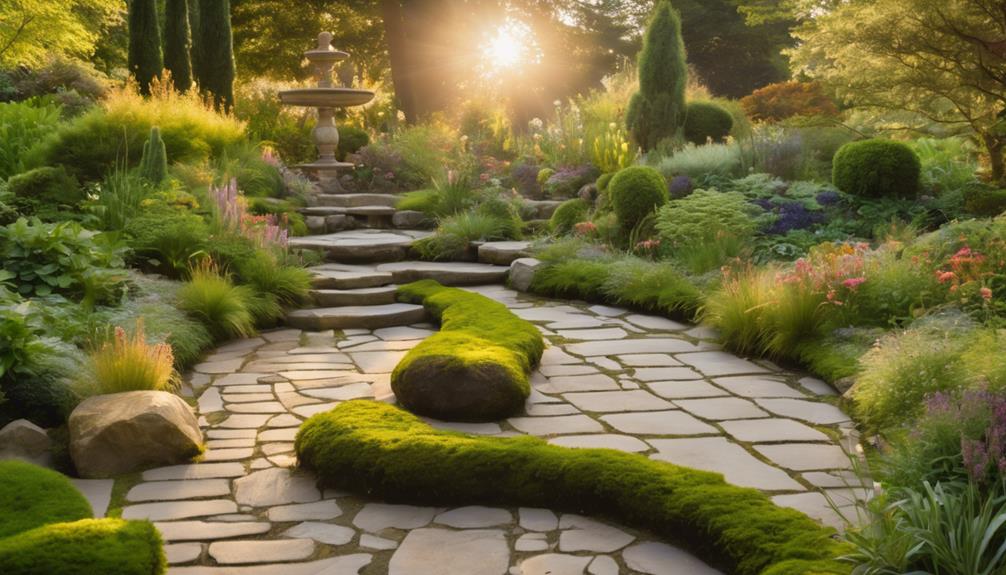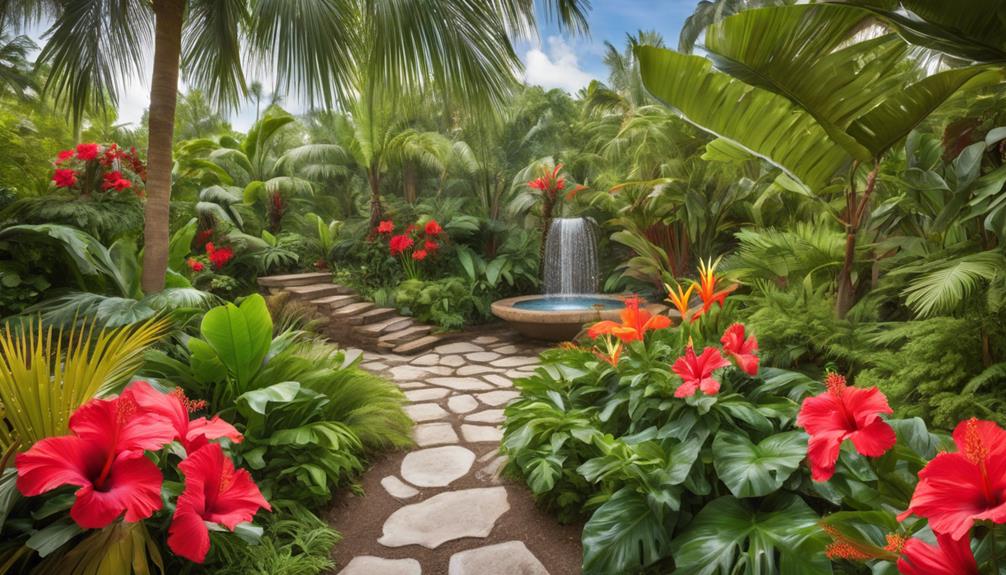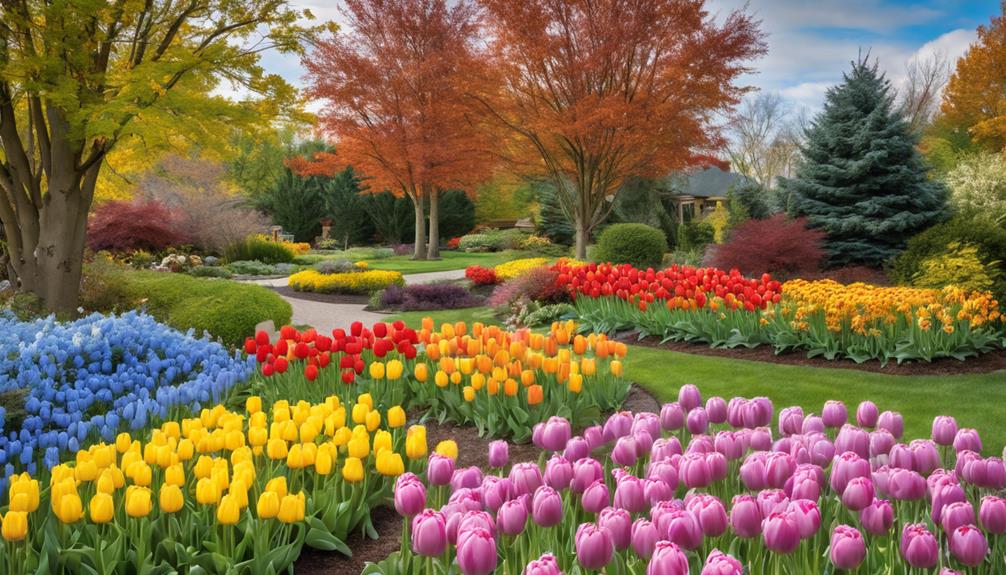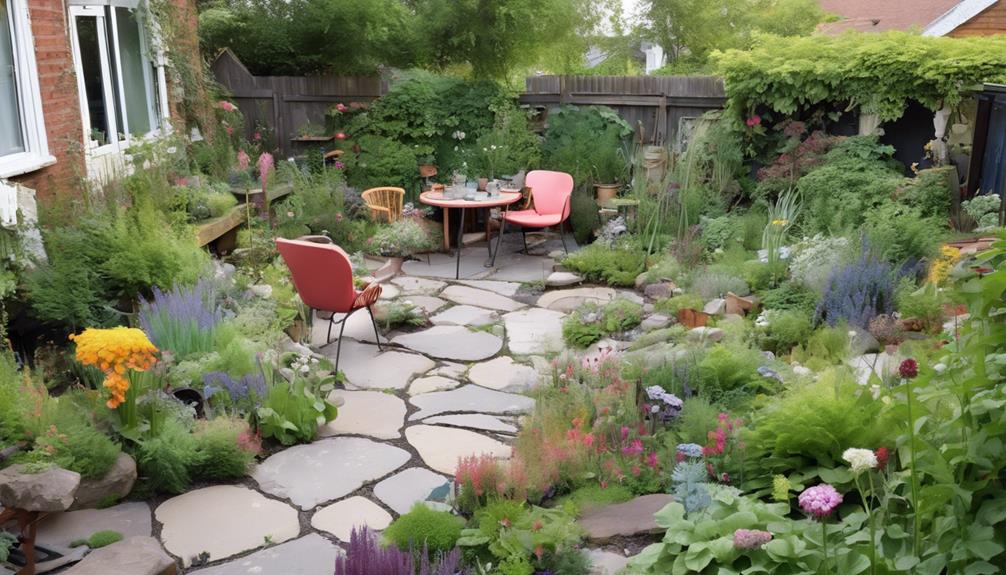
Top 10 Garden Maintenance Services for Vacation Homes
10 March 2025
Fence Repair Northfield
10 March 2025The three best therapeutic garden designs for mental wellness centre on the integration of nature, sensory engagement, and community involvement. Incorporating native plants enhances biodiversity while creating spaces that encourage exploration and reflection.
Sensory elements, such as water features and fragrant plants, stimulate emotional connections and relaxation. Furthermore, engaging the community fosters social ties, thereby reducing feelings of isolation.
Thoughtful layout planning includes accessible pathways and seating areas to promote inclusivity. Each design not only nurtures mental health but also adapts to seasonal changes, ensuring lasting benefits.
For those interested in cultivating their own wellness spaces, further insights await.
Therapeutic Garden Design Principles
Therapeutic garden design principles play an essential role in fostering mental wellness by integrating nature into the environment.
Employing nature integration techniques and sensory engagement elements can enhance the healing potential of these spaces.
Nature Integration Techniques
A variety of nature integration techniques play a crucial role in the design of therapeutic gardens aimed at enhancing mental wellness.
These techniques prioritise the seamless incorporation of natural elements, such as plants, water features, and natural light, to foster a restorative environment. Strategic placement of native flora promotes biodiversity, while their seasonal changes provide dynamic visual stimulation, enhancing emotional well-being.
Furthermore, the inclusion of varied topographies and organic pathways encourages exploration and movement, facilitating a sense of revelation. Integrating sightlines and secluded areas within the design offers individuals spaces for reflection and solitude, fundamental for mental rejuvenation.
Ultimately, these carefully considered techniques create a holistic framework that nurtures both the mind and spirit, promoting a profound connection with nature.
Sensory Engagement Elements
Incorporating sensory engagement elements into garden designs greatly enhances the therapeutic potential of these spaces. By integrating tactile, auditory, olfactory, and visual stimuli, therapeutic gardens can create a multi-dimensional experience that fosters mental wellness.
Textured surfaces, such as rough stones or soft moss, invite tactile exploration, while strategically placed water features produce soothing sounds that promote relaxation. Fragrant plants, such as lavender and rosemary, engage the olfactory senses, enhancing emotional well-being.
Visually, diverse colours and shapes stimulate the eye, encouraging mindful observation. Moreover, incorporating movement, such as wind chimes or swaying grasses, can evoke a sense of dynamism and tranquillity.
These sensory elements not only enrich the garden experience but also facilitate deeper connections with nature, ultimately supporting mental health.
Natural Light Exposure
Natural light exposure plays an essential role in enhancing the therapeutic benefits of garden designs aimed at mental wellness.
By incorporating colourful plant selections and textural diversity, gardens can stimulate the senses and promote emotional well-being.
Furthermore, sensory pathways can be strategically placed to encourage engagement with the environment, further amplifying the positive effects of natural light.
Colorful Plant Selection
Selecting colourful plants for therapeutic gardens plays a crucial role in enhancing mental wellness, particularly when considering natural light exposure.
The interplay of vibrant hues and bright sunlight can evoke feelings of joy and tranquillity, creating an inviting space for reflection and rejuvenation.
To optimise the therapeutic benefits, consider incorporating:
- Mood-boosting flowers such as sunflowers and marigolds that radiate warmth.
- Lush foliage with varying shades of green to create a calming backdrop.
- Seasonal blooms that provide evolving colours, fostering a sense of connection with nature's cycles.
Textural Diversity in Planting
Textural diversity in planting greatly enhances the sensory experience of therapeutic gardens, particularly when paired with ideal natural light exposure.
The interplay of light on different plant textures can evoke a rich tapestry of sensations, thereby enhancing the overall atmosphere and promoting mental wellness. By thoughtfully selecting a range of plant textures, designers can create inviting spaces that captivate the senses.
- Soft, feathery grasses that sway gently in the breeze
- Rough, rugged bark providing tactile contrast and stability
- Delicate, velvety leaves inviting touch and exploration
Such contrasts not only engage the senses but also foster a deeper connection to nature, cultivating a sense of peace and tranquillity that is crucial for mental well-being in therapeutic environments.
Sensory Pathways for Engagement
Creating sensory pathways within therapeutic gardens is essential for enhancing engagement and promoting mental wellness, with natural light exposure playing a pivotal role in this design element.
The thoughtful integration of light not only illuminates paths but also stimulates the senses, fostering a deeper connection with nature.
Consider these emotional benefits of natural light in sensory pathways:
- Increased mood elevation: Natural light elevates serotonin levels, enhancing feelings of happiness.
- Enhanced sensory experiences: Bright, well-lit areas allow for the appreciation of colours, textures, and scents, enriching the garden experience.
- Encouragement of physical activity: Well-lit pathways invite exploration, promoting movement and interaction with the environment.
Incorporating these elements creates a holistic space that nurtures the mind and spirit.
Garden Layout Planning
Effective garden layout planning is crucial for creating a therapeutic space that meets specific mental wellness goals.
This involves defining the garden's purpose, selecting sustainable materials, and incorporating creative vertical gardening techniques to optimise space and improve accessibility.
Define Your Garden's Purpose
A well-defined purpose is essential for any therapeutic garden, as it guides the layout and design elements that will contribute to mental well-being.
Establishing this purpose enables you to create spaces that resonate deeply with users' needs and aspirations.
Consider the following focal points when defining your garden's purpose:
- Reflection: Design serene spaces that encourage contemplation and mindfulness.
- Connection: Foster a sense of community through shared garden activities and communal areas.
- Healing: Incorporate elements that promote physical healing and emotional restoration, such as sensory plants or calming water features.
Sustainable Material Choices
Selecting sustainable materials is critical in the planning phase of a therapeutic garden, as it not only enhances the ecological integrity of the space but also fosters a sense of responsibility and connection to nature.
Thoughtful material choices contribute to a serene environment that nurtures mental well-being.
- Recycled wood: Utilises resources efficiently while reducing waste.
- Natural stone: Offers durability and timeless beauty that harmonises with the landscape.
- Native plants: Require less maintenance and support local ecosystems.
Vertical Gardening Innovations
Incorporating vertical gardening advancements into therapeutic garden layouts not only optimises space but also enhances the visual appeal and biodiversity of the environment.
By utilising vertical structures, garden designers can create immersive experiences that engage the senses and promote mental well-being. These innovative designs encourage interaction with nature, which has been shown to alleviate stress and anxiety.
- Enhanced air quality through increased plant density.
- Dynamic landscapes that evolve with seasonal changes.
- Accessible gardening opportunities for individuals with mobility challenges.
Embracing vertical gardening not only enriches the therapeutic garden's aesthetic but also embodies a commitment to sustainability and inclusivity.
Ultimately, this approach fosters a deeper connection to nature and enhances mental wellness.
Enhanced Mood and Relaxation
Many individuals find comfort and rejuvenation in carefully designed therapeutic gardens, where elements such as greenery, water features, and aromatic plants come together to create an atmosphere conducive to improved mood and relaxation. The thoughtful integration of sensory stimuli fosters a sense of tranquillity and promotes emotional well-being.
| Element | Benefits | Examples |
|---|---|---|
| Greenery | Reduces stress and anxiety | Trees, shrubs, flowers |
| Water Features | Enhances calmness | Fountains, ponds |
| Aromatic Plants | Stimulates positive emotions | Lavender, rosemary |
These elements cultivate an environment that supports mental clarity and emotional balance, allowing individuals to engage deeply with nature and experience profound relaxation. Through intentional design, therapeutic gardens become sanctuaries for mental wellness.
Therapeutic Plant Maintenance Strategies
Effective maintenance of therapeutic plants is essential for sustaining the mental wellness benefits that gardens provide.
Strategies such as creating mindfulness meditation spaces, engaging in community gardening initiatives, and organising therapeutic garden workshops can enhance the overall experience for participants.
These approaches not only foster a sense of connection with nature but also promote community engagement and personal growth.
Mindfulness Meditation Spaces
Creating mindfulness meditation spaces requires thoughtful consideration of both design and plant maintenance strategies to foster an environment conducive to relaxation and reflection.
Crucial elements include selecting plants that not only thrive in the chosen climate but also promote tranquillity and sensory engagement.
Key strategies for effective therapeutic plant maintenance might include:
- Regular pruning to encourage healthy growth and maintain aesthetics.
- Mindful watering techniques that promote a deep connection with the plants while ensuring their robustness.
- Seasonal rotations of flora to provide varied sensory experiences throughout the year.
Community Gardening Initiatives
Community gardening initiatives serve as a powerful means to improve mental wellness while fostering a sense of belonging and collaboration among participants. Engaging in the collective maintenance of plant life cultivates not only horticultural skills but also emotional resilience.
Such initiatives offer a structured environment where individuals can connect, share experiences, and grow together.
- Enhanced social connections lead to reduced feelings of isolation.
- Mindful engagement with plants nurtures a sense of calm and purpose.
- Shared responsibility promotes accountability and personal growth.
Through these therapeutic strategies, community gardens become sanctuaries of healing, empowering individuals to cultivate their mental health while contributing to a collective endeavour that uplifts the spirit of the community.
Therapeutic Garden Workshops
Therapeutic garden workshops often provide participants with hands-on experiences that enhance their understanding of plant maintenance while promoting mental well-being.
These workshops cultivate not only horticultural skills but also a sense of community and emotional resilience. Participants learn essential techniques that foster a deeper connection with nature, thereby enhancing their overall well-being.
- Experience the therapeutic power of nurturing plants.
- Uncover the joy of cultivating life and witnessing growth.
- Engage with like-minded individuals who share a passion for healing through nature.
Maintenance and Seasonal Changes
Effective maintenance of therapeutic gardens is vital for ensuring their long-term benefits, particularly as the seasons change.
Incorporating native plant species improves resilience, while water features can provide calming effects and attract biodiversity.
Adaptive planting techniques are necessary for addressing the varying needs of plants throughout the year, promoting a sustainable and nurturing environment.
Incorporate Native Plant Species
Integrating native plant species into therapeutic garden designs greatly improves both maintenance efficiency and adaptability to seasonal changes.
Native plants are well-suited to the local climate and soil, reducing the need for excessive watering, fertilisation, and pest control. This ecological harmony fosters a serene environment conducive to mental wellness, allowing the garden to thrive with minimal intervention.
- *Resilience*: Native plants adapt beautifully to seasonal fluctuations, ensuring year-round vibrancy.
- *Biodiversity*: They attract local wildlife, creating a dynamic ecosystem that enriches the garden experience.
- *Connection*: Engaging with native flora fosters a deeper appreciation for the local environment, enhancing emotional well-being.
Incorporating these species cultivates a sustainable sanctuary for healing and reflection.
Incorporate Water Features
Water features play a significant role in enhancing the therapeutic benefits of garden designs, complementing the use of native plant species. Their soothing sounds and visual appeal create a tranquil atmosphere that promotes mental well-being.
However, maintaining these features requires careful consideration of seasonal changes and ongoing upkeep.
- Emotional resonance: The gentle trickle of water can evoke peaceful memories and foster relaxation.
- Seasonal beauty: Water features can reflect the changing seasons, transforming the garden's ambience throughout the year.
- Wildlife attraction: Properly maintained, these elements can invite birds and butterflies, enhancing the connection to nature.
Adaptive Planting Techniques
While the beauty of a therapeutic garden can be maintained year-round, employing adaptive planting techniques is crucial to ensuring its resilience against seasonal changes.
By selecting plants that thrive in varying climates and adjusting maintenance strategies, garden designers can cultivate spaces that support mental well-being throughout the year.
Consider these impactful techniques:
- Seasonal rotation: Introduce plants that flower or provide visual interest in different seasons, creating a dynamic landscape.
- Microclimate utilisation: Utilise sun and shade patterns to improve plant survival and growth.
- Diverse planting: Incorporate a variety of species to promote biodiversity and resilience against pests and diseases.
Implementing these adaptive techniques not only fosters a visually engaging garden but also nurtures emotional well-being through ongoing engagement with nature.
Why Choose TKL Birmingham Gardener
Choosing the right gardener can significantly influence the success of your therapeutic garden, and TKL Birmingham Gardener stands out as an exceptional option.
Their extensive expertise in horticulture and landscape design ensures a holistic approach tailored to individual mental wellness needs. TKL Birmingham Gardener employs adaptive planting techniques and meticulously curates plant selections that promote tranquillity and sensory engagement.
Their commitment to sustainability and environmentally friendly practices further enhances the therapeutic value of your garden.
Moreover, TKL Birmingham Gardener prioritises collaboration, working closely with clients to understand their visions and preferences. This personalised service not only cultivates beautiful spaces but also strengthens emotional connections to nature, ultimately supporting mental wellness and fostering a healing environment.
Choosing TKL Birmingham Gardener is a step towards transformative gardening.
Common Garden Design Questions
When embarking on the journey of creating a therapeutic garden, it is natural for clients to have numerous questions regarding design and implementation.
Common inquiries often revolve around the selection of plants, layout, and sensory elements. Clients may ask, "What types of flora are best suited for relaxation and mental clarity?" or "How can I incorporate pathways that promote exploration and tranquility?"
Additionally, considerations regarding seasonal changes and maintenance requirements frequently arise. The importance of accessibility and safety within the garden space is another crucial topic, prompting questions such as, "How can I ensure my garden caters to all users, including those with mobility challenges?"
Addressing these concerns is fundamental to crafting a holistic and beneficial therapeutic garden experience.
Garden Design Implementation Guide
Designing a therapeutic garden requires a systematic approach to ensure that all elements work harmoniously together to promote mental wellness.
Begin by evaluating the space and identifying the specific needs of potential users. Consider integrating sensory experiences, such as fragrant plants and textured surfaces, to enhance emotional connections.
- Create secluded areas for quiet reflection and mindfulness.
- Incorporate water features to evoke tranquillity and relaxation.
- Select native plants that encourage local wildlife, fostering a sense of community.
Implementing these elements with intentionality ensures that the garden serves as a sanctuary for healing and rejuvenation.
Regular maintenance and adaptability are also key, allowing the garden to evolve and remain relevant to the mental wellness goals of its users.




